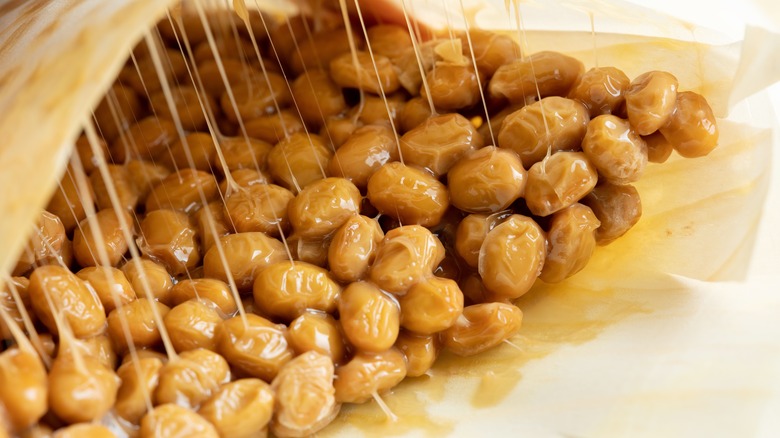Give Pungent Nattō A Chance And Put It On Some Toast For Breakfast
From blue cheese to Vegemite to pickled herring, there are many foods from all corners of the globe that, although delicious, pack a flavor punch so unique they may take some getting used to. This is certainly the case for nattō, a Japanese staple food made from soybeans. The beans are exposed to a specific bacteria found in rice straw — Bacillus subtilis — and left to ferment until they reach a thick, gooey consistency that gives off a powerfully pungent aroma.
Nattō is a cornerstone of Japanese food culture and is eaten daily across the island nation. While it can be consumed alone, this slimy snack is usually eaten with a mixture of ingredients and often served on toast. Both filling and packed with nutrition, nattō is one of the most common Japanese breakfast foods and is the perfect meal to try next time you need something quick and easy in the morning. Combining the distinctive condiment with crunchy bread for a toasty textural and taste contrast is a great way to highlight its virtues.
Try it on toast
To prepare nattō on toast, start by giving it a thorough stir. At the grocery store, nattō will likely come in a small plastic container that holds the beans and usually a few condiments, like soy sauce and mustard. Stir the sauce into the beans. As you stir, the nattō will develop a thick white goo that coats the beans and is extremely sticky — this is normal.
At this point, you can add the nattō directly to a perfect toasted piece of your favorite bread, or you can add in some additional ingredients. Try mixing in some mayonnaise to thicken the dish and give it a rich layer of creaminess. The Japanese brand Kewpie uses only yolks (instead of the entire egg) and will add a smooth umami taste to the toast. Beyond mayo, try mixing in bits of hard-boiled egg and some herbs, which will give the toast a soft, chunky texture. The mild, fatty taste of the eggs and mayo will coat the sharp, tangy taste of the fermented beans.
Nattō should always be refrigerated and is usually eaten cold, whether it's served on a simple bed of rice or warm pieces of toast. If you'd prefer to try the fermented beans in a hot dish, you can add them to miso soup, which has a strong umami flavor that will pair well with the pungent beans.
It's highly nutritious
In addition to bold flavor, nattō carries some serious nutritional benefits. A paper published in the journal Biochemistry Research International notes that fermented soybeans have an "antidiabetic effect" and that nattō specifically "contains vitamins and other important compounds that help to boost the immune system." The simple dish is also recognized as "one of the greatest sources of vitamin K," which is an important compound in bone production.
Nattō is also a probiotic filled with beneficial bacteria that could play a positive role in human health. In an interview with the New York Times, Dr. Ann Yonetani noted that modern diets "are exposed to too little microbial diversity" and that a single spoonful of nattō has healthy bacteria in numbers "orders of magnitude greater than what you would find in a typical probiotic food." In the same article, Dr. Ralph Holsworth shared that the bacteria fermentation process in nattō also produces nattokinase, an enzyme that he has studied and used in his medical practice. The enzyme aids the blood clotting process and ultimately "assists in the prevention of arterial plaque formation." So, the benefits of eating nattō on toast would seem to extend far beyond just being a tasty snack.


